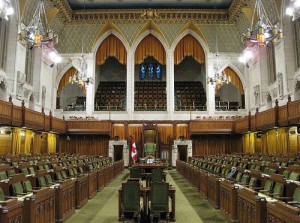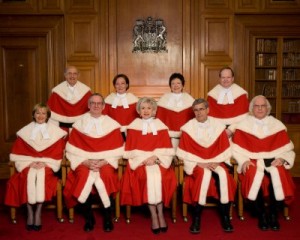This will be the first in a multi-part series in Dispatches from Canada about how we organize our country politically, and how we operate our system of parliamentary democracy. This post is going to be about the fundamentals, with the more esoteric stuff saved for later posts. Think of this as a foundation for the posts that come later.
Canada is organized as a federation – we have a federal government and ten provincial governments which are co-ordinate. This means that within their spheres of jurisdiction, they are sovereign, and can’t be overruled by the other level of government. Where jurisdiction overlaps, the federal government is supreme, which means that if it passes a law in that area, any parts of a provincial law which contradict the federal law are void. The powers of the various levels of government are distributed by sections 91 and 92 of the Constitution Act, 1867. This piece of legislation was known, up until 1982, as the British North America Act.
Municipal governments are not an independent level of government recognized in Canada’s constitution. As such, municipal governments only exist because the provincial governments have legislated them into existence. While it would never happen, this means that the provinces could theoretically legislate municipal governments right out of existence.
Canada has a standard tripartite separation of powers between the executive, legislative and judicial branches. The executive branch of the Canadian government and the Canadian head of state is technically the monarch, currently Her Majesty the Queen, Elizabeth the Second (or if you want to get all formal, Her Majesty Elizabeth the Second, by the Grace of God of the United Kingdom, Canada and Her other Realms and Territories Queen and Defender of the Faith). The monarch’s powers are formally exercised by the Governor-General of Canada, who is appointed by the monarch on the advice of the Prime Minister. Practically, however, almost every one of the monarch’s powers are exercised by the Prime Minister and the Cabinet in the name of the Governor-General. I will explain the process of selection of a Prime Minister in another post.

The legislative branch of Canadian government is the Parliament of Canada, and is something of a strange duck, because of some inheritances from Great Britain. Formally, the Parliament of Canada is composed of the House of Commons, the Senate and the monarch. The monarch is included because of fact that any statutes are formally enacted by the monarch, acting by and with the consent of the House of Commons and the Senate. As I will explain in more detail in another post, this creates a blended executive-legislative branch, in which the government of the day is directly accountable to the one elected body in Parliament, the House of Commons.
The judicial branch is a combined federal and provincial judicial system, which means that unlike the USA, we don’t have divided courts for matters of provincial and federal jurisdiction. The judicial branch is headed by the Supreme Court of Canada, nine justices appointed by the Governor-General, on the advice of the Prime Minister.
On a provincial level, the executive branch of government continues to be the monarch, this time as represented by the Lieutenant (pronounced lef-tenant, thank you) Governor. The Lieutenant Governor is appointed by the monarch on the advice of the Prime Minister. However, the powers of the Lieutenant Governor of a province are exercised by the Premier and Cabinet of that province. The Premier is to the provincial government as the Prime Minister is to the federal government.
The legislative branch of every province in Canada is different from the federal in that every province has a unicameral rather than bicameral legislature. That is every province has a single legislative chamber rather than having a lower and an upper house as the federal legislature does. For the most part a provincial legislature is formally known as the “legislative assembly”, though Ontario insists on calling its legislature the “provincial parliament” and Quebec insists on their legislature being known as the National Assembly. Ontario’s is probably due to us having a massively over-developed ego/an inferiority complex, and Quebec’s is probably due to a desire to flip off the rest of Canada.
The Canadian constitution is composed of three distinct parts: written statutes, letters patent, and traditional practices (known as “constitutional conventions”). The written statutes that define Canadian government are relatively few and far between. The Constitution Act, 1867, outlines the organization of the federation and divides powers between the federal and provincial governments. The Constitution Act, 1982, made some changes to the 1867 Act, provides the formula for making further changes to the constitution, and, most importantly, includes the Charter of Rights and Freedoms, a document that is closely analogous to the Bill of Rights in the American system.
The letters patent are documents from the monarch establishing various institutions and granting them powers. The most important letters patent in Canada are a series of such letters establishing and reestablishing the office of Governor-General of Canada and the provincial Lieutenant Governors. Constitutional conventions define many of the day-to-day workings of government, such as the idea that the Prime Minister is the person who leads a government which can command the confidence of the House of Commons (more on the concept of “confidence” in another post). They are unwritten rules and are unenforceable in courts, but without them, our system of government would not have sufficient content to function properly. They can be conceptualized as a hybrid of traditions and court precedents. Compliance with the constitution, to the extent that it can be enforced is up to the Supreme Court.

That is probably enough for now. If there is something specifically that you want to know more about or find interesting, let me know in the comments, and I will make sure to address it in future posts.
Picture of Centre Block from a Flickr belonging to geiarne, picture of the House of Commons from a Flickr belonging to Tomato Geezer and the picture of the justices of the Supreme Court is from the website of the Supreme Court of Canada.
